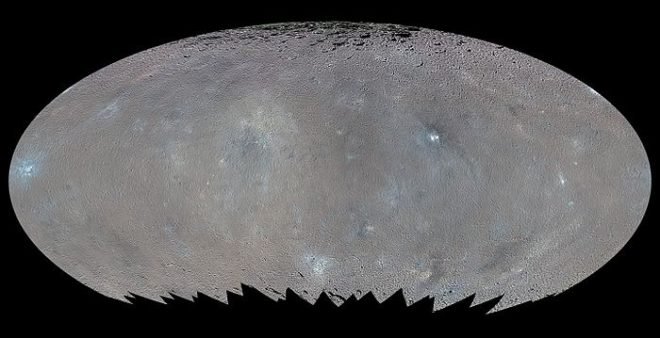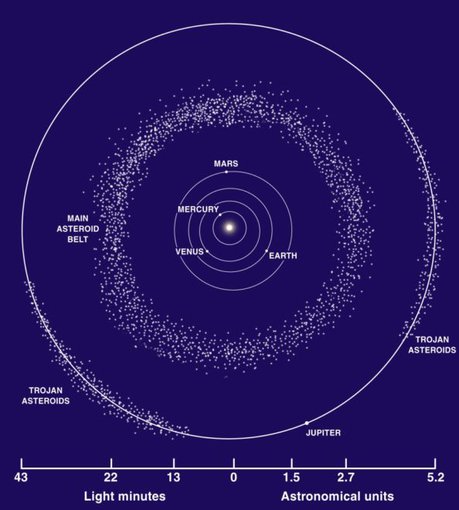
Feb. 21, 2017
Research Highlight
Ceres, Asteroids, and Us

Ceres, as imaged by the spacecraft Dawn on a high altitude orbit 900 miles from the surface. The several bright spots on the asteroid have been of particular interest to scientists and are believed to contain salts and ice. The image is mosaic formed from a series of images. (NASA/JPL-Caltech)
For most of us, asteroids exist primarily as a threat. An asteroid that landed around the Yucatan peninsula, after all, is generally considered to have set into motion the changes that resulted in the elimination of the dinosaurs.
Other large in-coming asteroids laid waste to swaths of Siberia in 1908, dug the world’s largest crater (118 mile wide) in South Africa long ago, and formed the Chesapeake Bay a mere 35 million years past. And another large asteroid will almost certainly threaten Earth again someday.
There is, however, a reverse and possibly life-enhancing side to the asteroid story, one that is becoming more clear and intriguing as we learn more about them where they live. Asteroids not only contain a lot of water—some of it possibly delivered long ago to a dry Earth— but they contain some pretty complex organic molecules, the building blocks of life.
The latest chapter in the asteroid saga is being written about Ceres, the largest asteroid in the solar system and recently declared to also be a dwarf planet (like Pluto).
Using data from NASA’s Dawn spacecraft, a team led by the National Institute for Astrophysics in Rome and the University of California, Los Angeles identified a variety of complex organic compounds, amino acids and nucleobases— the kind that are the building blocks of life. The mission has also detected signs of a possible subsurface ocean as well as cryovolcanos, which spit out ice, water, methane and other gases instead of molten rock.
“This discovery of a locally high concentration of organics is intriguing, with broad implications for the astrobiology community,” said Simone Marchi, a senior research scientist at Southwest Research Institute and one of the authors of the paper in Science. “Ceres has evidence of ammonia-bearing hydrated minerals, water ice, carbonates, salts, and now organic materials,”
He said that the organic-rich areas include carbonates and ammonia-based minerals, which are Ceres’ primary constituents. Their presence along with the organics makes it unlikely that the organics arrived via another asteroid.
In an accompanying comment in the Feb. 16 edition of Science, Michael Küppers of the European Space Astronomy Center in Madrid makes the case that Ceres might once have even been habitable.
The paper provides “the first observations of organic material on Ceres, confirming the presence of such material in the asteroid belt,” he writes. “Furthermore, because Ceres is a dwarf planet that may still preserve internal heat from its formation period and may even contain a subsurface ocean.”

Illustration of the minor bodies in the inner part of the Solar System, including Jupiter trojans and the main asteroid belt. These objects are byproducts of planet formation and have key information about that process. Detecting them in extrasolar systems may help us to understand the early evolution of planetary systems. (NASA)
Asteroids are as ancient as the solar system, some 4.6 billion years old. They are the leftovers from the planet formation process that took place in the disk around the very early sun — pieces of rock that didn’t become parts of planets or moons and weren’t otherwise smashed to bits.
Both their ages and their compositions have made asteroids increasingly interesting to space scientists studying how the solar system came to look and behave as it does. The result has been a suite of missions to asteroids organized by NASA, the Japanese Aerospace Exploration Agency (JAXA), the European Space Agency, the Russian space agency Roskosmos, and the China National Space Administration.
Many of the missions include substantial collaboration between different national space agencies. The Dawn effort, for instance, has major European involvement. NASA’s OSIRIS-REx mission to the asteroid Bennu and the Japanese Hayabusa2 mission to Ryugu each have three co-investigators from the other agency — a first and an advance from NASA’s more traditional participating scientist program. Both spacecraft are now on their way, will spend months on their destination asteroids, and are designed to bring home samples (in 2020 for Hayabusa2 and 2023 for OSIRIS-REx.)
NASA also approved two additional asteroid missions earlier this year. The first mission, called Lucy, will study asteroids, known as Trojan asteroids, trapped by Jupiter’s gravity. The Psyche mission will explore a very large and rare object in the solar system’s asteroid belt — an asteroid made of metal. Scientists believe it might be the exposed core of a planet that lost its rocky outer layers from a series of violent collisions. Lucy is targeted for launch in 2021 and Psyche in 2023.